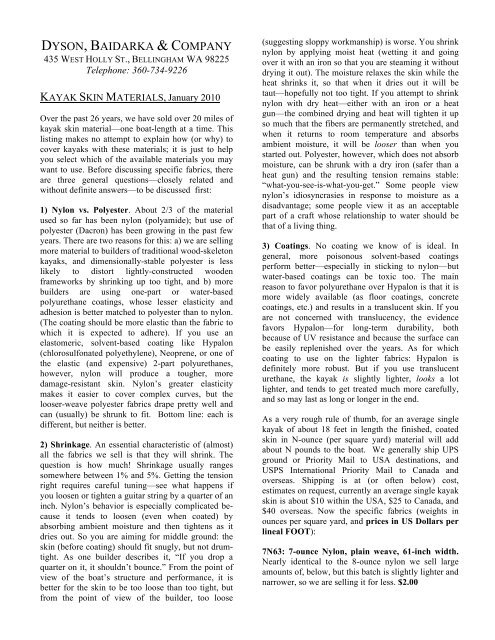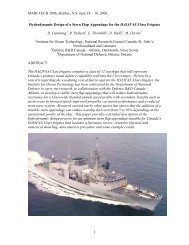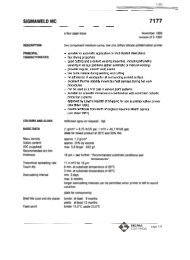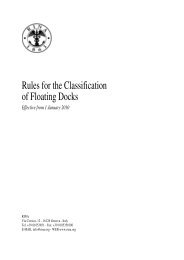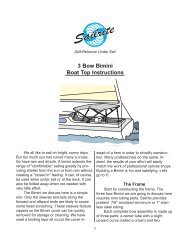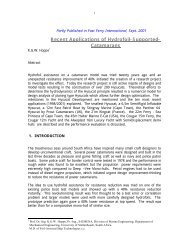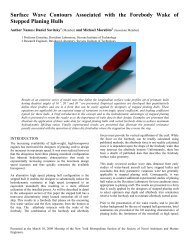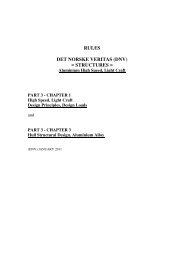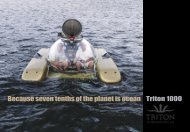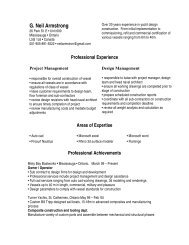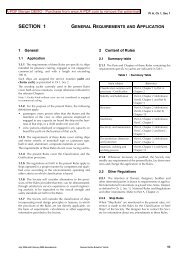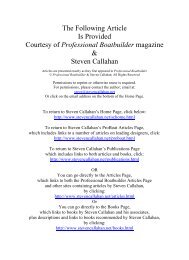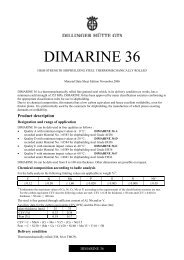DYSON, BAIDARKA & COMPANY - Boat Design Net
DYSON, BAIDARKA & COMPANY - Boat Design Net
DYSON, BAIDARKA & COMPANY - Boat Design Net
You also want an ePaper? Increase the reach of your titles
YUMPU automatically turns print PDFs into web optimized ePapers that Google loves.
<strong>DYSON</strong>, <strong>BAIDARKA</strong> & <strong>COMPANY</strong>435 WEST HOLLY ST., BELLINGHAM WA 98225Telephone: 360-734-9226KAYAK SKIN MATERIALS, January 2010Over the past 26 years, we have sold over 20 miles ofkayak skin material—one boat-length at a time. Thislisting makes no attempt to explain how (or why) tocover kayaks with these materials; it is just to helpyou select which of the available materials you maywant to use. Before discussing specific fabrics, thereare three general questions—closely related andwithout definite answers—to be discussed first:1) Nylon vs. Polyester. About 2/3 of the materialused so far has been nylon (polyamide); but use ofpolyester (Dacron) has been growing in the past fewyears. There are two reasons for this: a) we are sellingmore material to builders of traditional wood-skeletonkayaks, and dimensionally-stable polyester is lesslikely to distort lightly-constructed woodenframeworks by shrinking up too tight, and b) morebuilders are using one-part or water-basedpolyurethane coatings, whose lesser elasticity andadhesion is better matched to polyester than to nylon.(The coating should be more elastic than the fabric towhich it is expected to adhere). If you use anelastomeric, solvent-based coating like Hypalon(chlorosulfonated polyethylene), Neoprene, or one ofthe elastic (and expensive) 2-part polyurethanes,however, nylon will produce a tougher, moredamage-resistant skin. Nylon’s greater elasticitymakes it easier to cover complex curves, but thelooser-weave polyester fabrics drape pretty well andcan (usually) be shrunk to fit. Bottom line: each isdifferent, but neither is better.2) Shrinkage. An essential characteristic of (almost)all the fabrics we sell is that they will shrink. Thequestion is how much! Shrinkage usually rangessomewhere between 1% and 5%. Getting the tensionright requires careful tuning—see what happens ifyou loosen or tighten a guitar string by a quarter of aninch. Nylon’s behavior is especially complicated becauseit tends to loosen (even when coated) byabsorbing ambient moisture and then tightens as itdries out. So you are aiming for middle ground: theskin (before coating) should fit snugly, but not drumtight.As one builder describes it, “If you drop aquarter on it, it shouldn’t bounce.” From the point ofview of the boat’s structure and performance, it isbetter for the skin to be too loose than too tight, butfrom the point of view of the builder, too loose(suggesting sloppy workmanship) is worse. You shrinknylon by applying moist heat (wetting it and goingover it with an iron so that you are steaming it withoutdrying it out). The moisture relaxes the skin while theheat shrinks it, so that when it dries out it will betaut—hopefully not too tight. If you attempt to shrinknylon with dry heat—either with an iron or a heatgun—the combined drying and heat will tighten it upso much that the fibers are permanently stretched, andwhen it returns to room temperature and absorbsambient moisture, it will be looser than when youstarted out. Polyester, however, which does not absorbmoisture, can be shrunk with a dry iron (safer than aheat gun) and the resulting tension remains stable:“what-you-see-is-what-you-get.” Some people viewnylon’s idiosyncrasies in response to moisture as adisadvantage; some people view it as an acceptablepart of a craft whose relationship to water should bethat of a living thing.3) Coatings. No coating we know of is ideal. Ingeneral, more poisonous solvent-based coatingsperform better—especially in sticking to nylon—butwater-based coatings can be toxic too. The mainreason to favor polyurethane over Hypalon is that it ismore widely available (as floor coatings, concretecoatings, etc.) and results in a translucent skin. If youare not concerned with translucency, the evidencefavors Hypalon—for long-term durability, bothbecause of UV resistance and because the surface canbe easily replenished over the years. As for whichcoating to use on the lighter fabrics: Hypalon isdefinitely more robust. But if you use translucenturethane, the kayak is slightly lighter, looks a lotlighter, and tends to get treated much more carefully,and so may last as long or longer in the end.As a very rough rule of thumb, for an average singlekayak of about 18 feet in length the finished, coatedskin in N-ounce (per square yard) material will addabout N pounds to the boat. We generally ship UPSground or Priority Mail to USA destinations, andUSPS International Priority Mail to Canada andoverseas. Shipping is at (or often below) cost,estimates on request, currently an average single kayakskin is about $10 within the USA, $25 to Canada, and$40 overseas. Now the specific fabrics (weights inounces per square yard, and prices in US Dollars perlineal FOOT):7N63: 7-ounce Nylon, plain weave, 61-inch width.Nearly identical to the 8-ounce nylon we sell largeamounts of, below, but this batch is slightly lighter andnarrower, so we are selling it for less. $2.00
8N67: 8-ounce Nylon, plain weave, 67-inch width.Just about right—loose enough to drape acceptablyand tight enough to hold a seam. Shrinkage ismoderate, and well suited to lightly-framed woodenboats. [CURRENTLY OUT OF STOCK] $2.508PE70/76: 8-ounce Polyester, plain weave, 70 or76-inch width. Our lightest polyester—and still morethan twice the weight of the 3.7-ounce Dacroncommonly used for covering aircraft. Drapes andshrinks well, weave is a bit loose and has to be sewncarefully, but easier to work with than the 9-ouncepolyester twill we carried for a few years. $2.00 for70 / $2.50 for 76-inch width.12NB63: 12-ounce Nylon, 2x2 basket weave, 63-inch width. This is classic “ballistic nylon”—nowpopularized in sporting goods and luggage, if nolonger used in bulletproof vests. Basket weave(symmetrical over-and-under, but with two bundlesof fibers at a time) makes for a less-smooth butpleasantly textured surface. Weave is about right, andshrinkage is moderate. $4.0012NO54: 12-ounce Nylon, oxford weave, 54-inchwidth. Dense, tightly-woven material, will hold aseam exceptionally well, in a narrower width withless waste for covering narrower hulls. $3.0013PE79: 13-ounce Polyester, oxford weave, 79-inch width. This was the first polyester fabric wedistributed, and it has developed a small but loyalfollowing over the years, led by custom kayak-builderBill Low. This material has been almost fully preshrunk,so the weave is exceptionally tight—makingit somewhat stiff and difficult to use. Because of thedense structure, it takes very little coating to saturate,but there is very little porosity for the coating tomechanically adhere. Due to UPS length restrictions,it is much more economical to ship small quantitiesof fabric folded than rolled, but if you receive thismaterial folded, unfold it and roll it up smoothly asquickly as possible, since like permanent presspolyester trousers, it tends to hold a crease. $6.0014PE60 & 14PE72: With occasional minor flaws butat a great price. A basket weave polyester, somewhatlooser weave than the 16PE82 we have been sellingfor 10 years. Limited supply. $3.00 for 60-in / $4.00for 72-in.15N72: 15-ounce Nylon, twill weave, 72-inchwidth. We have been supplying this material (and thediscontinued 12-ounce version) to builders since1982, and it has proved its worth on many hundredsof boats—ranging from short retrieval kayaks and surfboats to 25-foot aluminum-framed triples and smallerumiaks and skiffs. The twill weave drapes easily, andholds coatings well. $6.0016PE82: 16-ounce Polyester, 2x2 basket weave, 82-inch width. We acquired a large run of this materialseveral years ago, and it has been well received butsupply is running out. Weave is a bit loose, but it willstill hold a seam and of the three polyester fabricsavailable it is the easiest to use. Shrinkage is moderateand easily controlled. The price width is enough fortwo narrow kayaks side by side, or you can staggerwider boats. $8.0026N68: 26-ounce Nylon, double weave, 68-inchwidth. An amazing fabric, which we discovered in1980 and which has withstood decades of severe abuseon many large, heavy boats. It is the heaviest materialwe sell, but it is also one of the easiest to use. Thethick, interlocking structure makes it behave more likereal sea-mammal skin than anything else we haveseen. Coatings penetrate and bond well, and becauseof the layered structure the surface can suffer seriousabrasion and the skin will still not leak. Unfortunatelyits manufacture has been discontinued, but we boughtup the last production run of this material and shouldhave it on hand for many years. Available only in 68-inch width, so wider doubles and triples require asmall patch on deck where the two sides of the fabricdon’t quite meet. Well-suited to covering large, hardworkingbaidarkas—and umiaks, too. $12.0029PE84: 29-ounce Polyester, double weave, 84-inchwidth. This ultra heavy-duty fabric is made assubstrate for conveyer belting. It has a very dense 3-dimensional weave and a flat, smooth surface. Wellsuitedfor umiaks or other large skin boats. $12.00459: 1.5-in Nylon webbing. For keel reinforcement,Mil-T-5038 spec. This is a thin nylon tape with a goodbalance between smoothness and texture, and a veryclean shuttle loom edge. $0.30/footPTW & BTB: Braided polyester twine (in White orBlack). Ideal for sewing skin material (& lashingskeletons). Approx 60-lb test high-tenacity polyester,holds knots well and lays flat, hollow core and veryfine braid. Approx 75 yards per ounce, made up inassorted size spools. $2.00/ounceGEORGE <strong>DYSON</strong>gdyson@gmail.com


